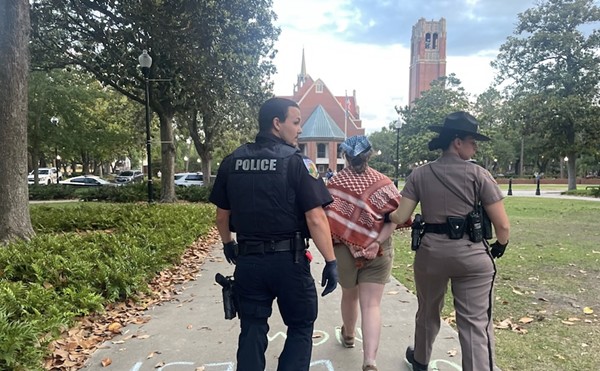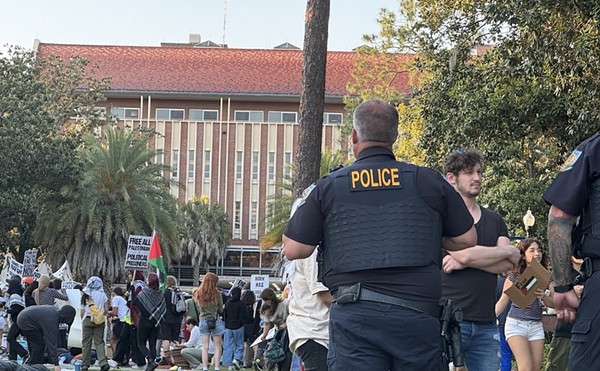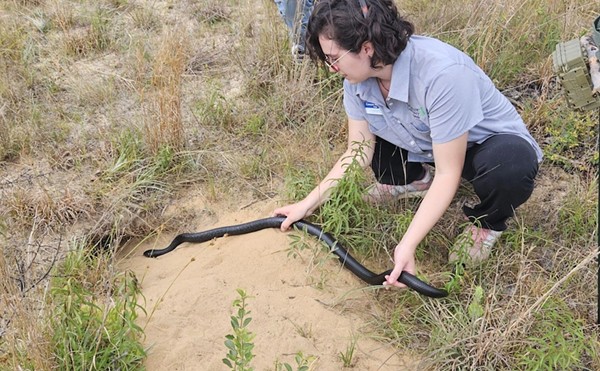On Feb. 12 at 6:18 p.m., police were dispatched to a meager second-story apartment at 125 1/2 Hibiscus Court to check on the well-being of its resident, 46-year-old Raymond Dewayne Kemp, who went by his middle name. There was no answer at the door, so they broke it open and found not only Kemp's dead body, but also that of 38-year-old Michael Terrance Land.
Initial television reports stated that Kemp, a diabetic electric contractor, had often allowed Land, a gay downtown waiter, to stay with him at his apartment. The police are still awaiting toxicology results to determine the causes of death.
For most neighborhoods such news would be a shocker; on Hibiscus Court, downtown Orlando's most unlikely street, it was just a bit less so.
Almost hidden away in the cobblestone thoroughfares of the quaintly revitalized Lake Eola Heights Historic District, Hibiscus Court is both anomaly and eyesore. Step onto the cracked pavement of its narrow, make-do path and you're in another world, far away from the home-owning elite just a block distant. It is a flimsy excuse of a road that ends at an even narrower one-way outlet and a fence. The 20 houses that line it are, for the most part, worse for wear.
Hibiscus Court is almost mythic in downtown folklore. Ask any denizen of downtown and they'll probably know someone who's lived there, or at least fallen down there. It's where the sidewalk ends, the road to nowhere, a real-life boulevard of broken dreams.
You can get high there. And it seems a lot of people die there.
"It's a nice neighborhood," says Harvey Biggs, an elderly Marine veteran whose Hibiscus home features baseball trophies twisted into the two posts that border his sidewalk and a Christmas tree whimsically perched on the roof during the holidays. Biggs is walking his dog, Cosmo, on Hibiscus a few weeks after Kemp and Land were found dead. "But everybody dies here," he notes.
‘It's a wonderful, charming spot, which kind of is a surprise," says Richard Forbes, the director of Orlando's Historic Preservation board. "I think it's a great asset to the historic district, especially when you look at how many of the structures are actually contributing structures from an early time period."
That means there are a lot of homes on the street built between 1919 and 1927, a boom period in downtown Orlando development, says Forbes. People were moving downtown in droves, thanks to Central Florida's budding economy of orange groves and real estate. "You couldn't build stuff fast enough," he says.
Hibiscus Court saw its first home built in 1923. It first shows up in the Florida Sun archives (old residence directories housed at the Orange County Regional History Center) in 1924 with four addresses, two of which were vacant. The following year, the street boasted five structures, three of which were inhabited; one by a real estate agent, Goland D. Krebs; one by Wilbert A. Weaver, who worked in the rug department of the nearby Dickson Ives department store; and the last by Elah S. Orton, for whom no profession was listed in the directory.
"It was a nice new neighborhood of everything from tiny little cottages to fairly substantial two-story Revival homes," says Forbes. "So it was sort of a middle-class neighborhood."
There has long been speculation by residents of the street that the small homes on Hibiscus Court were built to house the servants who worked at downtown mansions, but Forbes thinks that unlikely, considering that most of the area's elite resided in the Lake Cherokee and Lake Copeland areas.
Forbes also discredits the rumor that Hibiscus Court is the oldest street in Orlando. It isn't. The oldest house in the Lake Eola area appeared in 1894, a farmhouse on land that was eventually platted for homes because of the 1894 freeze that all but killed the orange grove economy.
But he acknowledges that there is no other street like Hibiscus Court in downtown. Its tiny lots and unusual cement paving (Orlando's downtown streets were brick-paved starting around 1906) present a historical quandary.
"It must have been that somebody had an idea, and it was probably to make the land more affordable," he says. "Obviously this lot would be more affordable than that one because it's about a quarter of the size. It was probably a way to do less expensive lots to give people more options to build."
As the homes, duplexes and apartments went up, the character of the street began to materialize. By 1934, gas station attendants, reporters, insurance salesmen and widows lived on the street (according to the Florida Sun archives). Charmingly, Maud Thomas — then the secretary and treasurer of the Orlando Shuffle Board Club — called the house at 206 Hibiscus Court her home.
Hibiscus Court lies just inside the border of the Lake Eola Heights Historic District, meaning that its contributing structures (those that match the character of the period and area) are protected from redevelopment. Noncontributing structures, like those on Hibiscus Court built in the postwar '50s (including the apartment building where Kemp and Land were found dead) are under their own set of redevelopment rules; they are not allowed to pretend to look older than they actually are.
Substantial redevelopment of the street — something that would seem obvious considering the property values of the surrounding area — is unlikely. "That would be very difficult," says Forbes. "If you tore something down, you wouldn't have a conforming lot to build something on."
Delite DeBolt, 43, purchased her 1925 home at 226 Hibiscus Court 10 years ago for $117,000. She runs her hearts of palm—importing business out of the Mission-style house, which she shares with her girlfriend, Linda Sullivan, 47.
"Originally, when I first looked at this house — I was looking at houses and the realtor brought me the flier, so I took a little drive, and at that time the house was listed at $130-something. And I said, I would never in my born days pay $135,000 to live on that shithole of a street. And then, when the realtor brought me in to look at the house — I had been looking at houses all day long — the high ceilings and the unique floor plan, I was sold. I was like, forget it, I don't want to look anymore. This is my house."
DeBolt may have fallen in love with the house, but her father didn't.
"When I went to buy this house, my dad co-signed on the loan with me, and he threw a fit and almost didn't show up to closing," she remembers, "because he thought I was buying the biggest piece of shit known to man. And I said, ‘Dad, just give me 10 years. I guarantee you that street's going to turn around, and what you don't realize is where it's located in the scheme of things downtown. It would just be a freak of nature if things didn't start to look up on this street. So he finally showed up for the closing."
It's been 10 years and things may be slowly improving — several neighbors have beautified their properties, one even winning "garden of the month" from the neighborhood association (Kemp himself won the food contest at the Lake Eola Heights Historic District block party last year for his Hibiscus Salad) — but in many ways the street is still a shithole. DeBolt laughs at the number of ambulances that have squeezed down the cramped thoroughfare, and is quick to make the popular "high-biscus"/"low-biscus" distinction between the two ends of the street (high being her end, low being the end where Kemp's apartment building is located). Until recently, residents had to hang their garbage bags on the slanted telephone poles in order to avoid trash-picking by the area's raccoon population. The poles are slanted, reportedly, because planners cut the connecting wires too short and so they had to lean them in toward each other.
The street is not without its charms. Sullivan likes the Key West feel of it — palm trees are prevalent, homes are close together — a feeling others in the area share. She and DeBolt have nicknames for some of their neighbors: the crypt-keeper lady, the little Lolita, the child molester, the crazy-haired lady, the yellow-mustache man (who died in the middle of the street). This isn't your average neighborhood roll call.
One of their favorite memories is of a gay man named Anthony Rega who lived halfway up the street, a rowdy and boisterous hellraiser who knew he was dying of AIDS. They say Rega was the soul of Hibiscus, always throwing bonfire parties and planting gardens. He stood at the middle of a neighborhood bohemia at the century's turn, central to a madness that included drugs, art, fashion, loud music and the runoff from a dying nightclub scene. Those were the halcyon days of Hibiscus Court.
"It's mostly people that don't live on the street," says freelance artist Pat Greene, 49, who rents a 1940 duplex unit farther down the street. "They always tell me that was where it was the only time they ever smoked opium, or ever did whatever, had a foursome."
Greene moved to Hibiscus Court in November because of its cheap rent (most small rental units on the street go for an unheard-of-downtown $450-$650 monthly rate) and the Key West look.
"It's really quiet," he says. "It seems like people really keep to themselves. The one thing I like about it, though: It doesn't seem like the rest of Thornton Park, where there's some sort of show going on. It just seems very down to earth."
Greene says he hasn't seen much crime, save the time the police were called on him by a neighbor who found a personal gathering too noisy.
DeBolt and Sullivan, who have been here for 10 years, have seen their share of petty thefts; a purse stolen from the back yard, a boat cover gone missing, change lifted from a car. They've seen 10 deaths on the street, the old men with their morning 12-packs of Busch stumbling back to their decaying apartments, the homeless people living in the hidden areas. They have no intention of leaving.
"In hindsight, I'm glad I bought on this street," says DeBolt. "Because where else can you sing karaoke until 5 in the morning without neighbors banging on the door?"
The city treats Hibiscus Court as its own entity. "It's not a street," says District 4 commissioner Patty Sheehan. "We would consider Geneva Place `the one-way at the end of the road` and `Hibiscus Court` substandard-sized streets. They're really kind of like alleys, and they're more or less just to serve the people who live there."
Sheehan is aware of the street's reputation, but says she's seen another side of Hibiscus. After the hurricanes of 2004, she helped out with the treecutting in the area and remembers everybody chipping in to help.
"I was going to go out and get a bottle of wine during the hurricanes and this guy drove up in a van and asked me if I needed anything," she says. "I gave him a 20 and he brings me back a bottle of wine. Where else do give someone 20 bucks that you don't even know, and they actually show up with your stuff?"
Depends on what kind of stuff you're after. Sheehan says she's aware of the perception of Hibiscus Court as a place where drugs can be found, but she also notes that the number of actual drug arrests on Hibiscus illustrate that it's not an open-air market.
Sheehan's police liaison, officer Jim Young, says the perception of the nature of crime on Hibiscus Court may not match the reality.
"As far as the type of calls, it's generally the same kind of things that we get everywhere else in the city," says Young. "It's pretty much all the same. Nothing out of the ordinary. Thefts, assaults (mostly domestic-related), a couple of burglaries; nothing out of the ordinary that we wouldn't get any other area."
But in this area, sometimes the crimes are a little more telling. On May 20, 2000, for example, at 133 Hibiscus Court, a young woman awakened her boyfriend with gagging sounds. Next to her lay a suicide note and piles of brown vomit. The boyfriend drove her to Orlando Regional Medical Center, himself high on some kind of drug, and revealed to authorities that she may have overdosed on his prescription of the muscle relaxant Soma. A nurse confirmed that the woman was indeed in a "Soma coma."
On May 11, 2001, a 13-year-old girl — the neighborhood Lolita — was found by her mother at a 42-year-old man's Hibiscus residence a few doors down. He was teaching her to play the card game Uno, and he was naked.
That very same girl would go on to amass numerous missing persons reports, called in by her mother over the years.
Ron, 45, who has asked that his last name not be used, resides in a rental unit on "low biscus." He didn't plan to arrive here. He flunked out of Auburn University twice, and finally got his bachelor's degree from the University of Central Florida in 1992. He went on to become a roofing-material distributor, who, upon hearing about the devastation of Hurricane Andrew in Miami, relocated down there.
"One day last May I just said I'd had enough and then threw my keys on the table and quit," he says. "Then I came up here, and of course it was because I was all whacked out on dope. I mean, I couldn't go 12 hours. I would get really sick. Been to rehab four or five times. I've been clean since last May."
Seated among the books and papers on the floor of his unfurnished apartment on Hibiscus Court ("This is what happens when you break up," he says), Ron mentions that he hasn't had any work for a couple of weeks, so he has some spare time.
He met Dewayne Kemp as soon as he moved to Hibiscus from his previous home, a run-down long-term hotel. Kemp's always-open door was just three doors down from Ron's. It was at Kemp's house that Ron found good food, friendship and generosity.
"He just made me feel welcome and was a really super-nice, outgoing guy," Ron says.
He describes Kemp's relationship with the other victim, Michael Land, as something of a love triangle that involved heavy drinking and cocaine abuse. A man named Nelson, Land's boyfriend, was the third point in the triangle, he says.
"Dewayne's opinion was that Nelson was using Michael because Michael was a waiter at Celebrity Deli and Michael had cash every day. So then Nelson would get Michael and they would go get drunk and then Nelson would buy dope with Michael's money, come over here and hang out here."
Land had been threatening suicide, Ron says, and Kemp had been taken by ambulance to the hospital twice prior to his death for insulin-related emergencies.
After a long weekend of partying in a limo, Kemp and Land were worn out. They came to Ron's apartment on Sunday morning and asked him to help them fetch Nelson from the woods. Ron declined. Later that evening, at about midnight, he noticed Kemp's lights were on and his bike was there, but nobody answered the door.
Ron, along with the building's landlord, spotted Kemp and Land through the window. When the authorities came and kicked in the door, Ron was right there behind them. In the front room, he found Land lying naked on the couch ("He looked like he'd laid down to die," Ron says). The room looked like a scuffle had occurred and there were Sweet'n Low packets all over the floor.
"I don't think there's any doubt that Michael committed suicide," he says. "The question is what happened to Dewayne. Did Michael intentionally overdose him? Did they scuffle and something happened to Dewayne and then Michael shot him (up)? Did Dewayne just expire naturally?"
At press time the toxicology reports had not been completed and there is no official cause of death listed for Kemp or Land.
When Kemp's parents arrived to gather what was left of their son's things, Ron approached them to tell them that their son had meant something to everybody on Hibiscus Court, that he was a wonderful person who wouldn't soon be forgotten.
"They didn't say anything," says Ron. "They just looked at me like he had gotten what he deserved."
The end of the road on a road that isn't even a road.
[email protected]

















